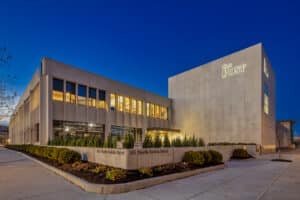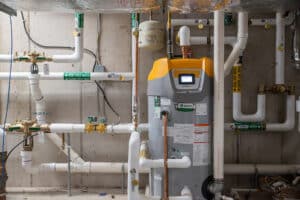The development of mixed-use spaces has become the focus of many architects and developers since urbanization and increased demand for downtown conduction is taking place in many cities. This trend is remaking the fabric of urban areas and bringing many neighborhoods back to life with social and economic activities.
What Are Mixed-Use Spaces?
Mixed-use developments are pedestrian-friendly complexes or buildings that blend two or more residential, commercial, cultural, institutional, and/or industrial uses.
The Urban Land Institute’s Mixed-Use Development Handbook defines mixed-use development as projects that:
- Provide three or more significant revenue-producing uses (e.g., retail, entertainment, office, residential, hotel, civic/cultural/recreation)
- Foster integration, density, and compatibility of land use
- Create a walkable community with uninterrupted pedestrian connections
In addition, the Harvard School of Design defined mixed-use as having multiple uses within one development, in which no component makes up more than 60% of the overall space.
Mixed-use development is on the rise in many communities. Learn more about the growth of mixed-use development.
4 Benefits of Mixed-Use Developments
The creation of mixed-use spaces is bringing many benefits to urban areas. Here are 4 quick benefits:
Benefit #1: Urban Renewal
Mixed-use developments offer more variety in the design of single and multi-family housing, which helps attract a diverse population to urban areas.
Benefit #2: Placemaking
Mixed-use projects are designed to encourage cultural activities and social connections. The architecture respects the heritage of the neighborhood and provides a sense of belonging and identity to the users.
Benefit #3: Reactivating Underutilized Space
Many mixed-use complexes are developed on compact areas of land, while others are built as expansions on existing buildings. This adds new functions and activities to the neighborhood.
Benefit #4: Reduction of Traffic, Parking Needs, and Pollution
The proximity of the various functions in a mixed-use development means inhabitants don’t have to travel as far or as much for their daily activities. Many of these developments incorporate bike-friendly and pedestrian-friendly features, re-introducing a “human scale” to the urban environment.
8 Trends in Mixed-Use Developments
With these benefits, mixed-use developments will become more popular in the next decade. Here are some trends that are driving the design of these projects and the revitalization of urban areas.
Trend #1: Face-To-Face Interactions and Social Connections
One of the biggest sociological trends behind urban revitalization is the desire for social interactions. The creation of common areas within commercial and residential spaces allow people to meet intentionally or by chance, and fosters the growth of communities.
Trend #2: Trading Private Spaces for Shared Amenities
As the co-living and co-working trends continue to grow and the sharing economy becomes mainstream, urban dwellers are choosing to have smaller private living spaces in exchange for common amenities such as a communal kitchen, gym, theatre room, children’s playroom, conference rooms, roof deck, swimming pool, etc. We’ll see more residential developments with shared amenities designed to encourage social interactions while increasing the convenience of urban living.
Trend #3: Pet-Friendly Facilities and Services
Around 60% of apartment dwellers have dogs and the availability of facilities such as dog parks, dog washing stations, and doggy lounges will affect their decisions in renting or purchasing within a particular project. In addition, developers will be renting out commercial spaces to retail businesses such as doggy daycare, grooming services, or dog walking services to attract pet owners.
Trend #4: Food and Beverage Offerings
Incorporating restaurants in a mixed-use development can help attract foot traffic and make a neighborhood come to life during evenings and weekends. In addition, many busy urban dwellers don’t have time to cook but prefer options that are healthier than takeout. We expect to see more stores selling high-quality grocery and prepared foods that are convenient and guilt-free in these complexes.
Trend #5: Precinct Programming and Community Activities
The design and incorporation of common spaces available to the public encourage residents to get involved and interact with the rest of the neighborhood. These spaces can be used for events, concerts, exhibitions, farmer’s markets, food trucks, etc. These types of events attract foot traffic, liven up the community, and boost economic activities.
Trend #6: Convenience
Incorporating retail to housing can increase convenience and save time for both residents and the community. The size of many mixed-use developments can help sustain retail and service businesses such as dry cleaning, convenience stores, and cafes which bring life to the street-level and make the complexes more attractive for residents. In addition, the availability of public transportation will be taken into account in the planning of these developments.
Trend #7: Sustainable Design
Mixed-use developments, which are often larger in scale than single apartment buildings, present opportunities to incorporate sustainable designs that are attractive to many environmentally conscious urbanites. We can expect more developments to be energy-efficient, use solar power, make use of natural light, and incorporate green spaces.
Check out Pike Block, a mixed-use redevelopment project in the city of Syracuse’s historic downtown. It incorporated trends like sustainability features and several common areas for residents.
Wondering how underutilized historic buildings get revitalized? Learn how historic tax credits benefit architects, engineers, and construction firms.
Trend #8: Diversity and Affordability
The new generation of urban dwellers is moving away from gentrification. They value diversity and inclusivity in their communities and we can expect more mixed-use developments that offer affordable or even government-subsidized units to foster the growth of diverse and vibrant communities.
Learn More about VIP Structures
VIP Structures is an integrated design-build firm in Syracuse, NY. Our company specializes in architecture, engineering, construction, and development disciplines to help organizations with building needs all across Upstate New York.
Interested in learning more about our services at VIP Structures?
Contact us below by filling out our short form. Subscribe to our blog for the most recent and up-to-date posts.




